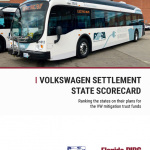Volkswagen Settlement State Scorecard
Ranking the states on their plans for the VW mitigation trust funds
Every state, with the exception of Florida, has now published its plan to spend the money being received as part of the Volkswagen emissions violations settlement. This scorecard grades each state’s plan on how well it is designed to take full advantage of the opportunity to invest in transportation electrification.
Downloads
Florida PIRG Education Fund

It has been about three years since Volkswagen settled with federal authorities for violating emissions laws in hundreds of thousands of vehicles advertised as low emissions.[i] The settlement included billions of dollars to buy back the offending vehicles from consumers, as well as nearly $3 billion for the Environmental Mitigation Trust, to be distributed to every state and territory where offending vehicles were sold.[ii] The Environmental Mitigation Trust funds are designed to be used for transportation projects that reduce pollution in an effort to mitigate the harm done by Volkswagen through their emissions cheating.
Under the terms of the settlement, states can spend their share of the Environmental Mitigation Trust funds in several different ways, including by purchasing newer diesel vehicles, natural gas vehicles, and electric vehicles, as well as repowering older diesel vehicles with newer engines or electric motors.[iii] States are also allowed to use up to 15 percent of their award on electric vehicle (EV) charging infrastructure.[iv] How each state spends its share of the funds within these allowable uses is up the state but must be set forth in a “Beneficiary Mitigation Plan” submitted to a trustee.[v]
Although technically allowable under the settlement, for states to spend this money on outdated diesel or other fossil fuel technology would be a wasted opportunity. The Volkswagen settlement money presents states with a unique chance to accelerate transportation electrification, and this money should be spent towards that goal. Long-term exposure to vehicle exhaust is associated with respiratory problems, especially in children.[vi] Transportation is the largest source of greenhouse gas emissions in the nation, and the cars and trucks on our road account for the majority of those emissions.[vii]
There is no question that we need cleaner vehicles on our roads – and there is no cleaner vehicle than an electric vehicle. No matter the electric grid, electric buses[viii] and electric vehicles[ix] produce less carbon pollution than their fossil fuel counterparts. Electric vehicles also have the advantage of getting cleaner as the power grid gets cleaner, and Americans have the option to power their buses and cars with renewable electricity. As a nation, we should be doing everything we can to accelerate the transition away from fossil fuel powered vehicles and plug into a cleaner and healthier transportation future.
Every state, with the exception of Florida, has now published its Beneficiary Mitigation Plan. This scorecard grades each state’s plan on how well it is designed to take full advantage of the opportunity to invest in transportation electrification.
States’ grades range widely, but our analysis finds that many are failing to make the most of this unique opportunity to electrify their transportation systems.
Washington and Hawaii earned a top-of-the-class A+ for spending as much as the settlement allowed on electric vehicle charging infrastructure and electrified mass transit buses and ferries. Rhode Island and Vermont both garnered A’s. Each state committed substantial amounts to accelerate electrification, including electrifying their mass transit systems.
Thirty-seven states receive a D or an F. To date, these states have developed plans that do not prioritize electric vehicles and instead make most, if not all, of the money available for outdated and polluting diesel or other fossil fuel-based technology.
But many of the states with poor grades still have an opportunity to redeem themselves. Their state plans set forth goals and priorities of each state, and detail what kinds of projects are eligible for funding. In large part, they set up a competitive grant process through which cities, towns, agencies, school districts, and companies can apply for funding for specific projects.[x] This means that, even in states that received low grades on this scorecard, there remains the potential that good projects that accelerate electrification could still be funded.
[i] David Shepardson, “U.S. appeals court upholds Volkswagen’s $10 billion diesel settlement,” Reuters, July 9, 2018, accessed at https://www.reuters.com/article/us-volkswagen-emissions/u-s-appeals-court-upholds-volkswagens-10-billion-diesel-settlement-idUSKBN1JZ21G; Russell Hotten, “Volkswagen: The scandal explained,” BBC News, Dec. 10, 2015, available at https://www.bbc.com/news/business-34324772.
[ii] “About the Settlement,” NASEO & NACAA VW Settlement Clearinghouse, accessed at https://vwclearinghouse.org/about-the-settlement/.
[iii] “About the Settlement,” NASEO & NACAA VW Settlement Clearinghouse, accessed at https://vwclearinghouse.org/about-the-settlement/.
[iv] U.S. EPA, Frequently Asked Questions (FAQ) For Beneficiaries to the Volkswagen Mitigation Trust Agreements, October 2017, available at https://www.epa.gov/sites/production/files/2017-10/documents/faq-ben.pdf.
[v] “About the Settlement,” NASEO & NACAA VW Settlement Clearinghouse, accessed at https://vwclearinghouse.org/about-the-settlement/.
[vi] Environmental and Human Health, Inc., The Harmful Effects of Vehicle Exhaust: A Case for Policy Change, 2006, available at http://www.ehhi.org/exhaust06.pdf.
[vii] “Sources of Greenhouse Gas Emissions,” U.S. Environmental Protection Agency, accessed at https://www.epa.gov/ghgemissions/sources-greenhouse-gas-emissions.
[viii] Jimmy O’Dea, Union of Concerned Scientists, Electric vs. Diesel vs. Natural Gas: Which Bus is Best for the Climate?, July 19, 2018, available at https://blog.ucsusa.org/jimmy-odea/electric-vs-diesel-vs-natural-gas-which-bus-is-best-for-the-climate.
[ix] David Reichmuth, Union of Concerned Scientists, New Data Show Electric Vehicles Continue to Get Cleaner, March 8, 2018, available at https://blog.ucsusa.org/dave-reichmuth/new-data-show-electric-vehicles-continue-to-get-cleaner.
[x] For example, Texas is now accepting applications for the first round of funding under its mitigation plan with more than $58 million for projects that replace or repower school buses, transit buses, and shuttle buses. See Texas Commission on Environmental Quality, “Texas Volkswagen Environmental Mitigation Program,” accessed at https://www.tceq.texas.gov/agency/trust (last visited May 10, 2019).